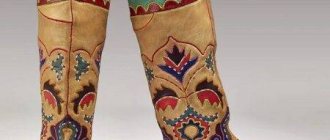A Moldavian wedding is truly a colorful, unforgettable celebration with a special southern flavor with its own traditions and customs.
And what songs and dances these people have! Whether you like it or not, your arms and legs will burst into dance! The newlyweds carefully prepare for the celebration of a Moldovan wedding a year before the celebration. When choosing a date, the church calendar is taken into account so that the selected day does not fall on a church holiday or fast. After the date is confirmed, the couple begins preparations for the important day in their lives.
Many questions arise, namely, compiling a list of guests, a menu of treats, searching for witnesses and “our guides.” According to Moldovan customs, every young couple should have “nashauls” - these are a kind of named second parents, whom the young couple themselves choose. In the future, this couple will be an example for their family life and will provide assistance in any issues related to housekeeping.
Original rituals
In the south of Moldova, when buying a bride, they traditionally dance the “Veil Dance”.
Previously, the groom brought the entire bride's outfit to the wedding, but now only the veil. The bride had to give a return gift - embroider a shirt for her future husband with her own hands. This is interesting: Azerbaijani wedding music - choosing dance songs together
They exchanged their gifts through witnesses. A vornichel with a shirt in his hands, and a vornichy with a veil, dance around the bride and groom, and they must either show agility or pay a ransom.
“Masa Mare” is a kind of ritual of collecting gifts from guests. The newlyweds and nanashi mutually wash their hands directly in the hall where the wedding takes place. Then the nanashi take turns approaching the guests, and they congratulate the newlyweds and throw money on the tray.
The amount is immediately announced publicly. After collecting all the gifts, the nanashi calculate the total amount of money collected at the wedding.
The bride treats the guests to cake, but only after she has taken off her veil and put on a scarf and apron. After this, gifts are laid out: sets, bed linen, blankets, and a pillow with a long needle. The groom is seated on a pillow, and the bride sits on his lap.
Nanash takes a needle in his hands and through the pillow stabs the groom in the sirloin. If the groom jumps up in pain and does not hold the bride in his arms, then he will not be able to cope with the pricks of fate in life’s troubles.
When he passes this test, his family will be strong and his love will be eternal.
Bottom line
Modern Moldovan weddings are often held in a European style, but they always include numerous traditional rituals. When you find yourself at a wedding in Moldova for the first time, it may seem that they are always buying something there.
The groom has to buy not only the bride, but also the shirt prepared for him by his future wife and the rolls. The bride buys the veil. Nanash buys the kalach and chicken. All rituals are accompanied by songs, and some by dances.
In general, weddings in Moldova are very musical and fun. We wish you the wedding of your dreams!
Moldavian traditions
First, let's look at the names of the iconic figures at the birth of a family. The groom's witness is called a vornichel. The groom invites his unmarried brother or friend to play this role. The bride's witness is called the groomsman.
This could be an unmarried relative or friend. Even at the engagement party, the parents of the newlyweds decide which of the invited guests they will choose as nanasha - the imprisoned parents who will marry the couple.
Nanashi is a married couple with a strong family. They should be older than the newlyweds, but younger than their parents. They not only take part in the wedding, but maintain close relationships with the newlyweds in the future.
The parents of the bride and groom make an offer to become nanashi at their children’s wedding, presenting them with butter rolls. It is not customary to refuse such an invitation.
Wedding ceremonies with rolls
At weddings, rolls appear in many rituals. The groom, having received the blessing of his parents, goes to Nanasha’s house with a roll on a towel to solemnly invite them to the wedding. He presents them with a kalach, and they accept it.
The groom with his friends and nanashi go to the bride's house.
They are greeted by the bride's parents with a kalach on a towel, which personifies patronage. They lift it up, and the groom and his escort pass under it. The groom must buy this kalach - a symbol of parental protection.
Then the bride ransom begins, which is called the “goat hunt.”
The bride gives a silent sign that she agrees to marry the groom. The friend silently pulls the knife from the joint.
The newlyweds cross the threshold of the banquet hall under a roll of bread held in the hands of the groom's parents. Then the mother-in-law wraps a towel around the newlyweds and leads them into the hall. Nanash buys the kalach from the vornichel and gives it to the newlyweds, showing his patronage with such a gesture.
Vornichel can sell the groom or give away the kalach for free, which the newlyweds must tear. Whoever has the majority of the roll in his hands will become the leader in the family.
Rituals with chicken
Baked chicken appears twice at the wedding. For the first time, it is placed on the bride’s dowry, which is given to the groom who has bought his betrothed. It is believed that the chicken is a symbol of family prosperity.
Therefore, the newlyweds must eat it themselves, without sharing it with anyone.
For the second time at the banquet, the “Chicken Dance” will be announced, which is also called the “Dance of Masks”. It is danced by the cooks who have prepared the wedding meal before our dinner. In their hands they hold a bottle of wine, on which is placed a baked chicken, decorated with ribbons and colored paper.
During the dance, they offer to buy back the chicken, meaning payment for their work as a cook. Nanash pays generously for the chicken offered to him.
Wedding in Moldova: dressing the newlyweds
A Moldavian wedding begins with the preparation of the bride and groom for the holiday. Friends and witnesses help dress the young people. The groom is dressed first. Together with his comrades, he goes to the Nanashi’s house, where the ceremony of invitation to the wedding takes place. According to custom, the groom hands over rolls of bread neatly laid out on an embroidered towel to the seated father and mother. Having accepted the kalachi, the married couple agrees to become nanashi. Further, the witnesses, who in Moldova are called vornichel and druzhka, and nanashi, go together with the groom for his beloved.
The Moldovan bride also goes through a dressing ceremony, in which her bridesmaids help her. The ritual is accompanied by beautiful songs dedicated to saying goodbye to the parental home and friends.
Culture
Folk art of Moldova can be considered a real treasury. Over their long history, Moldovans have managed to create a lot of spiritual values, making a great contribution to world culture. There are many churches, cathedrals and temples here. Each of them is unique in its own way. For example, the Kalarashovsky convent demonstrates a typical Slavic architectural style, while the Cathedral is more European. The monumental image of the Capriana Monastery makes a strong impression and often arouses admiration among tourists
Music is no less important for the people. Moldovans honor national traditions and use instruments that have no analogues in the world
The nai wind instrument is a very unique one, which is a multi-barreled flute (can consist of 8 or more pipes). The attitude towards music in Moldova can be compared to fanaticism. Many residents are interested in this type of art from an early age. A striking example is Cleopatra Stratan, who began performing on stage at the age of 3 and was listed in the Guinness Book of Records as the youngest performer in the world. Humor is another type of national treasure. Moldovans often like to joke, considering humor the most important phenomenon in human life. Humorous skits are regularly shown in theaters; residents have been familiar with jokes since childhood. Everyone's favorite fairy tale is the story of Pekale and Tyndale.
https://youtube.com/watch?v=uUcbfaYOugg
Features of the culture of Moldova
Residents of Moldova are very careful about their heritage and are happy to share the heritage of their ancestors with everyone who wants to hear and see. These friendly, hospitable people welcome fun and holidays with plentiful food. At celebrations, they always sing melodious folk songs and dance energetic, fiery dances. And how beautiful and original are traditional dresses decorated with embroidery! It was in Moldova that incredibly beautiful carpets and hand-embroidered masterpieces were created.
Traditional marriage rituals
Wedding celebrations were traditionally scheduled in the fall. After the end of the harvest season, the best time came for a walk with the whole world, and with all the breadth of the soul. The bins were bursting with fresh fruits and vegetables, and the new wine was ripening, and the main hard work in the fields was over.
A wedding in Moldova was never hastily planned. A year, or even more, passed from the young couple's meeting to the wedding day. All this time, preparations were being made for the grandiose action and the subsequent feast. Every little detail was scrupulously taken into account, and the wedding date was chosen with all care: it should not fall on fasting or unfavorable days. Wedding witnesses and nashaul advisers were selected. They could only be a strong married couple, older than the newlyweds, but younger than their parents, who would help the newlyweds during the celebrations, and then begin to give wise advice in family life.
Matchmaking and engagement
The ancient traditions of a Moldovan wedding involve a mandatory matchmaking ritual. For this purpose, favorable days were always chosen - Thursday, Saturday or Sunday, but not on major church holidays or on days of fasting. Matchmakers were sent to the chosen girl's house, and the presence of the groom was not required. They described in colorful terms all the advantages of the young successful hunter who had spotted such a desired prey. In allegorical speeches and careful observance of the time-honored ritual, there is a sacred meaning: only in this way will the future family be protected from misfortunes.
If the girl’s parents gave preliminary consent to the marriage, then her personal belongings were handed over to the groom or his representative. Then followed a heated bargaining between both parties, when a ransom, sometimes quite serious, was demanded for the bride. Once the parties reached an agreement, a date for final agreement was set. This time, usually up to two weeks, was given to think and weigh all the pros and cons. At the end of this period, the agreement could either be confirmed or terminated without mutual claims. After this, an engagement was scheduled. Usually the preparation for it lasted about seven to ten days.
On this day, the bride's relatives paid a return visit to the groom's house, making sure that everything said about him by the matchmakers was true. And a young hunter is a truly worthy choice; he is a strong owner with skillful hands and will be able to adequately support his family. Hospitable hosts served a rich feast, and a leisurely conversation began. They discussed the details of future wedding celebrations, the list of guests, the day and the bride's dowry were set.
Considerable disputes often flared up over the size of the dowry. Usually the girl was given luxurious hand-embroidered carpets and carpet runners for the floor, embroidered towels and linen, and kitchen utensils. The boy’s parents, for their part, allocated a plot of land, materials for building a house, a work horse and tools.
Preparation period
The selection of nashauls was approached with great care. Not every couple was suitable for such a responsible role. And without their presence, the wedding could not have taken place at all - this is as indisputable an element of a Moldovan wedding as the newlyweds. The chosen married couple had to have family ties with the newlyweds and be happily married. Also, an important criterion was their strong financial situation and willingness to help and mentor the young family.
Invitation cards were baked goods lovingly baked by the hands of the young housewife - bagels, rolls or gingerbread. Ignoring an invitation was considered a serious insult, so such a responsible mission was not refused without a serious reason. In essence, these people became second parents for the newlyweds.
Nowadays, good acquaintances, friends of parents, or married couples from among the newlyweds’ peers are invited to play the role of nashauls. After this, an application for marriage registration is submitted to the registry office, a banquet hall is selected and booked if the wedding is planned to be held in a restaurant, and the holiday scenario is specified.
Traditional robes and modern outfits
National wedding costumes of Moldovans are masterpieces, hand-embroidered with amazing patterns. Making them takes a lot of time and effort, but it is worth it - no store-bought dress can compare with the exquisite simplicity and amazing patterns of folk wedding vestments. Silk, dyed cotton threads, beads, and beads are used for embroidery. The base is white, onto which red, black and blue patterns are sewn. Shirts, sashes and trousers are sewn for the groom, the dress for the bride must be embroidered along the hem, collar and sleeves, and an embroidered apron and belt are tied.
Matchmaking process
The first conversation between the relatives of the future husband and wife takes place on the day of matchmaking. Matchmakers are sent to the apartment where the girl lives. Their main obligations are to describe the groom's advantages and resolve certain issues.
Matchmakers predict the decision in advance. They find out about the intentions of the bride's relatives. The matchmaking process takes place on certain days: Thursday, Saturday or Sunday. Church holidays should not fall on these days. These days are considered lucky.
According to tradition, matchmakers make several requests.
- The bride is presented as the prey, and the groom appears as the hunter.
- A bargaining takes place between the future husband and the girl’s relatives.
- There is a statement of fact that there is a bride and groom.
Each side communicates its intentions, after which several actions are performed that are prescribed by the customs of the people. Moldovans believe that following all traditions helps protect the future family from bad events. The positive answer is the transfer of personal belongings to the future spouse.
After matchmaking, the engagement date is set. On this day, the bride gives the final answer. The difference between these two events is from 3 to 7 days. The bride is allowed to change her mind within 2 weeks.
On the day of the engagement, the girl's relatives came to the groom's home. This visit made it possible to verify the veracity of the groom's intentions. The man’s financial condition and ability to manage household affairs were assessed.
The bride's dowry was always discussed. If the future spouse and his relatives refused their decision in due time, then the bride could, if she wished, perform an unusual ritual called “On the Stove.” This process gives her the right to rescind the refusal and proceed with the wedding event with the groom, despite the opinion of his parents.
If the groom's relatives refused the wedding, the girl could be kidnapped.
What happens after the wedding?
After the wedding, parents' day is held. It begins at 2 o'clock in the afternoon and continues until late in the evening.
On this day, newlyweds wear modest clothes. And their parents and nashauls opt for old things, since according to tradition they are beaten with nettles or smeared with mud. If relatives do not want this to happen, they have to pay off.
The second day is different in that strong chicken broth with homemade noodles is placed on the table. No meat or sweet dishes are consumed. Also on this day, competitions are held and dancing is performed.
A Moldavian wedding combines many traditions and customs of different nations. This allows you to make the holiday more colorful, fun and bright. National rituals must be preserved. In this way, young people show their respect and how much they value the culture of the people, and pass it on from generation to generation.
What do they eat on holiday in Moldova?
A Moldavian wedding, like many celebrations, is characterized by pomp, fun and noise. Guests are served cold cuts and national dishes. If the event is held in the fall, it means there will be a rich table. This is due to the fact that at this time of year the harvest is harvested. The holiday in Moldova is distinguished by the serving of homemade delicious and aromatic wine.
Dishes in the form of Moldavian gogoshars and fekeluite beans are used as appetizers. Meat dishes include entrecotes and zrazy. The first courses include chorba and zama. Flour products in the form of rolls, Easter cakes, plancinda and vertut are always present on the table.
TOP 20 songs for celebration
At Moldovan weddings, guests have fun from the heart. They sing funny songs and dance a lot.
We have presented a list of the most popular songs performed at weddings:
- Omsk.
- Syrba.
- Trampoline.
- Green leaf, white maple.
- Spottykach.
- Fae ver de.
- Nanay nara nanay.
- Dirli-Dinga.
- Dulce – I ca.
- Nynta.
- Viata de haiduc.
- Cinci Chiperi.
- Mole shtianu.
- Mai Jorota undeai fost.
- Hoata, Hoata.
- Hai saruta-ma.
- Fata warrior.
- Perem, perem.
- 'n mai pentru salavoi.
- Moldavian slow choir.
The last song is performed while removing the veil from the bride. At Moldovan weddings, not only invited musicians and performers sing, but also guests. Guests perform songs both during rituals and feasts. The collective performance of folk songs creates a special emotional atmosphere at a wedding.
https://psvadba.ru/moldavskaya-svadba.htmlhttps://svadba.expert/podgotovka/traditsii/po-narodam/moldavskayahttps://marry.guru/organizatsiya/muzyka/moldavskaya-svadba
Wedding preparations
The most crucial moment in preparing a wedding celebration in Moldova is the choice of weddings. This is the second couple, whose presence is as mandatory as the presence of the young. Without them, the wedding simply cannot take place.
Making a choice is not easy; there are special criteria. Thus, a married couple who:
- necessarily older than the young, but younger than their parents;
- has family ties with young people;
- fairly wealthy;
- ready to become a patron and mentor of a young family.
Gingerbread cookies, rolls or other rich pastries serve as an invitation letter in this role. Refusal is considered a sign of disrespect, so generally the couple accepts the gifts and agrees. The duties of nashauls include assistance in organizing a wedding, supporting the newlyweds during the celebration and helping them during their future family life. In fact, they become second parents for the young. Today, the role of nashaul can also be played by acquaintances of married couples, friends of parents or newlyweds.
The next stage of preparation is submitting an application to the registry office, booking a restaurant, final collection of the dowry, clarifying the details of the script for the celebration itself, etc.
Selection of catches
One of the most important moments in preparation is the selection of our catches. This concept is usually understood as the second couple, which is necessarily present at the wedding celebration.
The young people face a difficult choice. Only married couples become nashaulami. In this case, several criteria are taken into account.
- They must be older than the bride and groom, but younger than their mother and father.
- To be wealthy and wealthy people.
- Willingness to become patrons and mentors of the bride and groom.
Gingerbread, rolls or buns are used as invitations. If guests refuse an invitation, it is considered a sign of disrespect. That's why people most often accept gifts. The duty of the nashauls is to organize the wedding celebration and support the newlyweds in all their endeavors. They are considered the second parents of the bride and groom. In modern times, acquaintances, friends and parents of newlyweds are chosen for this role.
The next stage of preparatory activities is submitting an application to the registry office and booking the premises where the celebration will be held. A dowry is also collected and a holiday script is drawn up.
General information
How does matchmaking work?
According to the old custom, matchmakers from the groom are sent to the bride's house. Usually they are relatives or friends of the groom who have known him for a long time and will be able to tell the bride and her family about all the positive qualities of the future husband. Therefore, often the first conversation between relatives of both parties can take place on the day of matchmaking. Even for matchmaking there are certain favorable days. This is Thursday, Saturday or Sunday. In this case, church holidays must be taken into account.
Moldovans try to adhere to these stages of matchmaking, and indeed all traditions, because they believe that this protects the newlyweds from misfortunes and hardships in their future family life.
After matchmaking, the newlyweds begin to choose an engagement date. According to customs, it must take place no later than 7 days from the date of matchmaking. Until this day, the bride still has time to carefully think about her decision and give her final answer.
The engagement procedure usually takes place in the groom's house. During it, the bride and her relatives have the opportunity to check the groom’s firm intention for marriage, evaluate the declared skills and abilities to manage the household and household chores. And also assess the man’s financial condition.
But it also happens that after agreements on matchmaking and engagement, the groom, after a certain time, refuses to marry the bride. In this case, the bride has the right to use an unusual ritual called “On the Shoulders”
It gives the girl the right to ignore the refusal and hold a wedding with the declared groom, without taking into account the decision of his parents
If the bride's relatives refused the wedding, then the groom could easily kidnap the bride for a secret wedding.
Selection of catches
The young couple takes their choice of fish very seriously. After all, this couple will subsequently accompany the family all their lives.
In terms of their proximity to a young couple, these people are equivalent to second parents. And from the moment of selection, their responsibilities included assistance in conducting and organizing the wedding celebration of the newlyweds. They are usually relatives, acquaintances or the parents of the young people themselves.
The next issues that should be dealt with in preparation for the wedding are submitting an application to the registry office and drawing up a script for the celebration. And for the bride, this is collecting her dowry.
Moldavian bride – ransom of a beauty
A wedding in Moldova involves an unusual ritual before the first meeting of the newlyweds. You will be surprised when you learn how the bride is bought in Moldovan traditions. When the groom arrives at his beloved’s house, an interesting custom occurs - bargaining for the bride. A sharp knife is inserted into the door frame, which symbolizes the gate. The bride must give symbolic consent to get married. If she agrees, the groom takes a knife from the door frame and lets the groom into the house of his beloved. Next, the parents bless the couple, and everyone goes to register the marriage.
Appearance
Cloth
The production of national costume still exists, although it is rare to find weavers who used old looms. However, folk craftsmen still live and delight people with beautiful outfits. The everyday national costume of Moldova is worn on holidays and festivals. A sleeveless vest, a sheepskin coat, and a hat should always be present in the wardrobe. Girls usually did the spinning. It can be said that this has been a national pastime for many years. They made clothes from linen and wool. Modern outfits are made from cotton fabric. Making a traditional costume required skill: the experience was passed on from generation to generation for several centuries. Women's clothing consisted of an apron and a skirt, and men's clothing consisted of pynze and aba pants with shiyak. Women's shirts were embroidered with ornaments, tied with a woolen belt, and a blanket was thrown over the top, partially covering the head. A basma scarf was put on the head. Not only men wore vests; women needed peptar to protect themselves from the cold. A wool cloak provided good protection from the rain. Women's outfits were the most festive. The men were distinguished by restraint. It was necessary to wear a cap for the holiday. The man tied his shirt with a wide belt with a long tassel. They wore thick leather boots on their feet. Dance ensembles wear special outfits designed to demonstrate choreographic art. They are distinguished by their variegation and the predominance of ornaments that demonstrate nature. The costumes of the masters of applied arts also look different from others. For example, women wore shirts with wide sleeves and wore a veil around their waists: work was often carried out on the streets, women had to sit on wooden benches for a long time, so the veil made it possible to protect the lower back from hypothermia. Making folk costumes was considered important because it had cultural value. Now orders for production more often come from foreigners collecting national costumes. Their cost can be quite high, but this does not affect demand in any way.
After the wedding
The second day after the wedding is considered parenting day. It starts at two o'clock in the afternoon and lasts until the evening.
In this video they will tell you everything about the traditions of a Moldovan wedding:
On this day, it is customary to come in more modest clothes, and parents and nashauls choose very old things, since, according to tradition, they can be beaten with nettles or smeared with mud. If they don't want it, they'll have to buy it off. On the second day’s table they put a strong chicken soup-broth with homemade noodles - “zamu”.
On this day they ride on carts and hold fun moving competitions and, of course, dance, dance, dance.
This is a Moldavian wedding. Revelry, cheerful, with a nod to tradition and faith. Would you like to participate in such a wedding?
Ritual of undressing the bride
Weddings in Moldova are distinguished by another unusual tradition - the undressing of the bride. The ritual involves removing the veil and giving this item to an unmarried friend. The groom needs to give the boutonniere that was on his jacket to his single friend. Afterwards, the friend dances with the girl who was given the veil.
The undressing of the bride is also characterized by tying a scarf on her head. This gives the girl a new status as a “wife”.
Five year anniversary before the wedding
— Anatoly and I have known each other for a long time, since school. At first we just talked, then the communication grew into friendship, and after some time it turned into something more. I remember that we started dating on May 9, 2022.
We can say that the relationship has been tested by time. We dated for a total of five years before getting married. Shortly before the wedding, we celebrated our fifth anniversary. It was very symbolic for us.
Marina and Anatoly started dating in May 2022. Shortly before the wedding, they celebrated the fifth anniversary of their relationship.
Anatoly made the marriage proposal to me alone, in a cozy homely atmosphere. It was touching, with a ring and flowers - everything as it should be. But I can’t say that the offer came as a surprise to me. Rather, on the contrary, it was expected, because we had been together for a very long time and, of course, everything was heading towards creating a family. And yet the moment still turned out to be exciting for both of us.
Amazing Moldovan wedding traditions: Strange, but very cute
Moldavian weddings and wine have made us famous throughout the world as cheerful people, a little crazy and unrestrained in our fun, but strictly traditional. Surely many of our readers can boast of a deep knowledge of Moldavian wedding rituals, but believe me, dear ones, this is exactly the case when there is more to come. That is, the deeper you go into the Moldavian steppes or forests, the more you learn, the more you are surprised.
And no Internet, no eyewitnesses will be able to clearly explain why they stick a knife into the doorframe before ransoming the bride, or why the “vornik” gives the newlyweds a baked chicken at the moment of handing over the dowry. We will not take responsibility and draw conclusions, we will only tell you about several wedding customs that baffle city guests, lead rural guests into ecstasy and cause bewilderment among foreigners. In addition, we will try to trace their origins and find at least some logic in throwing water at the feet of the unfortunate groom.
Redemption of a veil, a sad song, a shirt for the groom
No matter how hard we try, we cannot avoid comparing the original traditions with their modern versions. For example, the “veil dance” or “shirt dance”, so popular in the south of Moldova (not in Gagauzia), will shock any unprepared spectator. But this is a mandatory ritual for dressing the bride and groom.
We decided to get married after two months of dating
— We met on March 19, 2022 in Prague. We both worked there at McDonald's at the time. Taras was the manager, and I worked there in the kitchen. From our very first meeting we realized that we had found each other. It was love at first sight. We communicated more and more every day and eventually realized that we couldn’t live without each other.
And two months later he proposed to me. It was over dinner in one of the Prague restaurants. The atmosphere was romantic and beautiful, as if we were in a fairy tale. I gave my consent without hesitation and we immediately began an accelerated preparation process. Taras immediately promised to take care of all the organizational issues and give us the best wedding, so we decided to get married in his homeland in Stryi.
I supported and helped my fiance in every possible way in matters of organization. The most important thing was to choose a date, but this question disappeared by itself. Immediately after the proposal, Taras called his friend from Stryi and asked him to book a banquet hall at the Villa Gray restaurant. Free dates were only on September 1 and November 20. We settled on a September date, which we found convenient and beautiful.
The young people got married on September 1, 2022, five months from the day they met. The celebration took place in the city of Stryi, the groom’s homeland.How does matchmaking and engagement work?
Moldovans begin the first official conversation about the upcoming wedding at the bride's matchmaking ceremony.
Matchmakers are sent to the young woman's house. Their responsibilities include a detailed description of all the advantages of the future groom and posing the main question.
Matchmakers should anticipate the answer in advance by finding out about the parents’ intentions to marry off their daughter. Mandatory days for matchmaking were: Thursday, Saturday or Sunday, if major church holidays did not fall on them. They were considered successful. Traditionally, there are several matchmaking requests when:
- the bride is represented as the prey, and the groom as the hunter;
- bargaining is carried out between the groom and parents for the bride as for a commodity;
- the fact is stated that there is a bride and groom.
In all these cases, the participants clearly communicate the intentions of the parties by performing certain actions prescribed by custom. According to faith, this helps protect the future family from misfortunes. A positive response to matchmakers is the transfer of any item of the bride into the hands of the groom. His presence, by the way, is not necessary.
But most young people do not miss the opportunity to participate in this ritual.
At the end of the matchmaking, the day of engagement and the day of the final answer are set. The time difference between them can be a week. The total time to think and change a decision is two weeks or more.
On the day of the engagement, the bride's parents came to the groom's house, checking the veracity of the matchmakers' words about his condition and ability to run a household. At the set table, the details of the future wedding, the day, the number of invited guests, etc. were discussed.
Customs of a Moldovan wedding
The traditional celebration began with a visit to the house of the Nashauls. The festively dressed groom, bowing, respectfully held out a freshly baked pastry on an embroidered towel, asking him to become the seated parents. Meanwhile, relatives and friends looked into every house, calling all the neighbors to the wedding. After which the groom, accompanied by nashauls and witnesses, went for the bride.
At the girl’s house they were greeted by a locked gate and very determined men of the family. The groom and best man came forward and respectfully told the old legend about the lord and the beautiful forest fairy. And they said that a long and difficult road had brought the young prince to the house where his beloved lived. The gates were opened, but the groom’s trials did not end there.
Rite of vestment
Before the wedding, the bride was dressed by her friends in the outfit brought by the groom. Ritual songs of farewell to girlhood, to parents and stepfather's house were sung. When ready, she went out to the groom and guests, presenting her gifts on an embroidered towel - a shirt and belt, entirely made by her.
Bride ransom ritual
Before seeing the bride, the groom had to go through difficult tests prepared for him. A sharp knife was definitely woven into the joint. If the bride agreed to the wedding, her witness removed the blade, and the groom received the right to lead her down the aisle. The bridesmaid and his best man, with all possible help from the Nashauls, organized various tests and competitions, where the groom appeared as a skilled hunter, an excellent worker and a competent owner, and the bride acted as a trembling hunted doe and a beautiful fairy.
The house greeted guests ceremoniously decorated with embroidered towels, garlands and wreaths of flowers, ribbons, canopies of richly embroidered fabrics, carpets and runners. Sweet baked goods were always present on the tables - rolls, bagels, gingerbread.
Now ancient traditions are diluted with modern inclusions. Questionnaire posters are drawn, poems, humorous songs and quizzes are composed that suit the occasion. Competitions include both those with whom our great-grandmothers and great-grandfathers married, as well as modern ones.
All arrangements in the bride's house depend entirely on the bridesmaids; they are the ones who set the tone for the holiday.
Wedding ceremonies and modern marriage registration
A wedding in a church was necessarily preceded by confession and holy communion the day before. Also, preliminary conversations were held about the value and sanctity of family ties. The bride entered the temple only with her head torn; for this, a shawl or veil of the finest workmanship was prepared. They never entered the temple drunk or even after drinking wine.
Before the marriage ritual, the newlyweds broke the rolls and treated all the single guests. When the wedding train left the gate, the bride's mother threw grains of wheat and small sweets after her to ensure well-being and harmony.
Ceremonial feast and folk dances
Moldova is famous for its hospitable people, generous with food. Weddings were celebrated with all their hearts, with tables laden with a wide variety of dishes. Both cold and hot dishes of national cuisine, young wine, fruits and berries were sure to be present.
Traditional dishes were stuffed peppers, mashed beans, entrecotes and zrazy. Vegetable soups with meat or fish broth, broth with vegetables and eggs were also served. A huge amount of sweet pastries was piled on flat dishes. These are a variety of rolls, pies with fillings, fried flatbreads and rolls.
Songs and dances are an obligatory attribute of a Moldovan wedding. Not a single identity can do without them. Live music, beautiful voices, melodic national songs and fiery round dances - well, how can you sit still here? The following dance rituals remain obligatory to this day: “Veils”, “Shirts” and “Masks”.
Wedding organization
Wedding dresses
Moldavian national wedding dresses are very bright and festive, with their own twist. The predominant color in clothing is white. According to local traditions, wedding clothes are trimmed with beads and multi-colored threads in red, black or blue with appropriate patterns, which gives them extraordinary originality.
The process of dressing is somewhat unusual in this country. And it consists of several stages. The young groom is dressed first. But before that, he must visit the house of the chosen “nashauls” and invite them to the wedding. To do this, the groom, together with his friends and witness, presents the named father and mother with rolls laid out on a beautifully embroidered white towel. After accepting the treats, the couple agrees to become planted parents. And they all go to the bride’s house together.
Only after this the bride carries out her dressing ritual. The witness and her friends help her with this. This is probably the most touching moment in which the girls sing songs dedicated to the bride’s farewell to her home and her friends.
Ransom of a young bride
And now the long-awaited wedding day comes! A Moldavian wedding, like everything else, begins with a bride price. The Moldovan custom is practically no different from ransoming Russian brides. The only difference is the name of the newlyweds' witnesses. From the bride's side - "Druzhka", from the groom's side - "vornichel".
At the ransom, it is the witnesses who actively bargain and are the ringleaders of the entire process. The scenario for such a ransom is simple and somewhat similar to the matchmaking procedure. During the ransom, various images of the bride are used. She can act as a “commodity”, “forest nymph”, “doe”, and the groom can be a brave “hunter”, boyar or merchant. And all this with poems, songs and jokes. As payment for the bride, not only real money is accepted, but also sweets, baked goods and small symbolic souvenirs and gifts. But still there is not much difference in the ransom of this people. And it lies in the fact that the bride’s parents attach great importance to the decoration and decoration of the house at the time of buying their daughter.
It is considered mandatory to have in the house:
- Brightly embroidered towels;
- The presence of many fabrics and multi-colored ribbons. Red ribbons, which are considered a symbol of a fire in the house, are not permitted;
- Wreaths of flowers were placed everywhere;
- There must be fragrant rolls on the tables.
Marriage registration
After buying the bride, the couple goes to the registry office to officially register the marriage. Many newlyweds additionally undergo a wedding ceremony in a church or temple.
In this case, one day before the wedding, the young people must go through the process of communion and confession. And also attend a conversation with the priest on the topic of the rules and values of family life. It is not mandatory, but attendance is encouraged. When visiting the temple, the bride must have her head covered. It is strictly forbidden to attend a wedding after drinking alcohol, so the newlyweds are not offered alcoholic treats until the end of the official part of the wedding.
Festive feast
After the official part, it’s time for festive fun and congratulations to the newlyweds. Usually this part takes place in a restaurant or in the groom's house, where he will bring his wife. According to Moldavian custom, on the way to the holiday, a bucket of water can be unexpectedly poured at the feet of the newlyweds. For young people, this is a surprise comparable to future obstacles in their future family life. And here it is important to pass this test with a smile on your face. After all, from this moment they are together and nothing should interfere with their happiness. It is from this moment that the solemn part of the feast begins.
Before entering, the newlyweds are served a kalach, which they must bite into and feed to each other, dipping the pieces generously in salt with the sentence “Let this be the only salt that we inflict on each other.” Then fun competitions and traditional rituals are held. Congratulations are heard and national music plays. Everyone is dancing and singing merrily. The Moldovan wedding feast is considered an obligatory attribute of a wedding celebration, which not only congratulates the newlyweds, wishing them happiness and prosperity, but also warns about difficulties and adversities in family life.
Moldovan dancing at a wedding
We consider the first dance of the newlyweds to be the main dance of the celebration. This is usually romantic wedding "chora" music. It is selected by the newlyweds several months in advance. It is performed in one breath and becomes a symbol of the family for many years.
The most popular dance among Moldovan weddings is considered to be an ordinary round dance, but always accompanied by live music. As a rule, all guests of the celebration dance together with the bride and groom in this dance. It is not uncommon to see the “Shirt” dance and the “Mask” dance at such events.
Treats at a wedding
Moldovans try to hold weddings in the autumn season after the harvest. In this case, the festive table will be rich and abundant. During this period, Moldova is famous for its vegetable and fruit harvests, as well as a good period for tasting delicious homemade wine.
Guests are treated to cold cuts and national dishes. Traditional appetizers include dishes in the form of gogoshars in Moldavian style and fekeluite beans. The most common meat dishes are entrecotes and zrazy. The first courses are chorba and zama. There is always a variety of sweet pastries on the table in the form of Easter cakes, kalachi, as well as plancind and vertut.
Ritual of undressing the bride
After the end of the wedding, a very important moment comes and is considered a national Moldovan custom - this is the undressing of the bride. It consists of the following: the veil is removed from the bride’s head and given to the bride’s closest unmarried friend. A scarf is tied to the bride’s head, which changes her status from bride to “wife.”
The groom, in turn, removes the boutonniere from his jacket and gives it to his single friend. A girl and a young man dance together after receiving things from the newlyweds. And the newlyweds go to their first wedding night.
After the wedding
The day after the wedding is considered parent's day. It starts after 2 pm and continues until the evening. On this day, guests, parents and newlyweds dress simply. According to the traditions of the Moldovan people, on the second day, all invitees are beaten with stinging nettles and stained with mud. To avoid this fate, guests are given a chance to pay off, and the proceeds are sent to the family budget of the newlyweds.
What are guests treated to at a Moldovan wedding?
A wedding in Moldovan villages always means lush tables and cheerful, noisy celebrations. On the table there are classic wedding cuts, as well as national Moldovan dishes, beloved by local residents. If the wedding takes place in autumn, then expect a magnificent table, because it is at this time that the country harvests vegetables and fruits. Moldova is also famous for its delicious aromatic wine, without which no holiday is complete. If you are lucky enough to attend a Moldovan celebration, the website for newlyweds Svadebka.ws would recommend that you try the national dishes.
Snacks:
- Gogoshary in Moldavian
- Fakeluite beans
Meat dishes:
- Entrecotes
- Zrazy
First meal:
- Chorba
- Zama
Flour products:
- Kalachi
- Kulichi
- Placinda
- Vertuta
Traditional Moldovan dances
Not a single wedding in Moldova, just like a traditional wedding in Turkey, is complete without national dances. Most often, Moldovan dances at a wedding are accompanied by live music, which creates an even more soulful atmosphere at the celebration. One of the popular dances is the hora - a traditional fiery round dance that guests dance with the newlyweds. Looking at the active and fiery dances, not a single guest can resist starting to dance. Also at Moldovan weddings there may be traditional “Veil Dance”, “Shirt Dance” and “Mask Dance”.
Martisor Holiday
The spring holiday of Martisor is considered one of the most beautiful traditions in Moldova. It is celebrated on the first day of spring and is also associated with a folk legend. Spring, coming into its own, cleared the ground of snow to help the first flower, the snowdrop, emerge. Winter, not wanting to give way, got angry and launched a blizzard on the beautiful Spring. She, protecting a snowdrop from the wind, scratched herself on the thorns of a thorn tree. Drops of blood fell on the snow.
The symbol of the holiday is considered to be decorations woven from red and white threads - martisors. Residents of Moldova give them to each other in honor of the onset of spring. These delicate decorations are worn for a whole month, and at the end of March they are hung on trees in the forest, while making cherished wishes. It is believed that they always come true.
Folk crafts
The oldest craft in Moldova, pottery, has earned recognition in many parts of Europe. Handmade ceramics are decorated with national ornaments and designs depicting animals and plants. Pots and other earthenware are widely used in Moldavian cuisine; baked vegetables and meat are especially tasty.
Moldavian woodcarving masters create delightful patterned souvenirs and interior items. Decorating wooden buildings with carvings is also common. The houses in the Calarasi, Rezin and Straseni regions of Moldova are especially beautiful.
Each nation has its own unique traditions and customs. Moldova is a country with a special flavor, its cultural heritage is distinguished by bright colors and sunny mood.
Celebrating a Moldovan wedding
Moldovan weddings have some similar customs to neighboring countries. Some customs were borrowed from Ukraine, some from Romania. Since Moldova also has a Jewish community, both Moldovan and Jewish wedding rituals can be observed at the celebration of the two nations. Traditionally, the meeting of newlyweds takes place with rolls, just like in Russia and Ukraine - with bread and salt. You need to dip a piece of kalach in salt and feed it to your soulmate. Next, the guests are treated to homemade wine and begin to congratulate the newlyweds. After congratulations, the newlyweds and guests begin the meal.
Outfits of Moldovan newlyweds
In Moldova, at weddings that take place in villages and villages, they often resort to national traditions, including in clothing. Traditional costumes in Moldova are real works of art. As a rule, decorating outfits takes a lot of effort and time, because they are hand-embroidered with threads and beads. The key color remains white - the main color of the wedding. However, the suit can be embroidered with red, black and blue threads.











